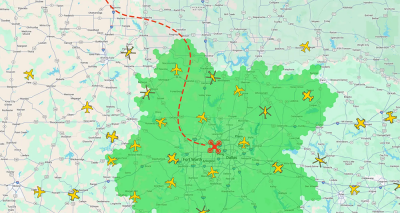Recently, Commercial UAV News held “The Key to Scaling Drone UTM and Fleet Management” webinar, to discuss about what it takes to scale drone operations and safely integrate them into the national airspace.
For the panel, we brought together four industry leaders, who are helping to push the industry forward, to understand what the challenges are, how to overcome them, and what needs to happen next to further grow the drone industry. Although the panelists, Lisa Peterson, Vice President, Business Development and Marketing at Airspace Link; Brendon Mills, CEO & Managing Partner at Fortsol; Ken Stewart, President and CEO at Northeast UAS Airspace Integration Research Alliance (NUAIR); and Brian Garrett-Glaser, Managing Editor at eVTOL.com brought up a number of important topics and salient points, here are five high-level takeaways about the state of UTM and fleet management that we took from the webinar.
Crawl, Walk, Run
While there already are some companies, like Wing, Manna Aero, and Zipline, performing daily drone deliveries, the industry is still far away from where it wants to be. When asked about some of the challenges toward scaling operations and advanced Air Mobility, Garret-Glaser’s said that “this is very crawl, walk, run, and it's going to be sequential revolutions rather than all at once.” Getting drones to transport goods or people while flying over cities is something that will take a lot of time to happen.
“I've asked a lot of the delivery carrier companies what's their timeline for real, day-to-day operations of drone deliveries, and it's still five years out, at least,” Mills commented. “They're still doing experimental pilot-based activities, so, that’s still ways out before it happens.”
NUAIR’s 50-mile drone corridor in New York should help to bring us closer to that reality at a faster pace by allowing agencies, as well as OEMs, and USS providers to perform drone testing operations, including BVLOS. “You can test at a test site – crawl -, move to the corridor - walk -, and run by enabling the deliveries,” Stewart said.
Public Acceptance and Relationship Building
An important part of scaling and growing the drone industry is by getting everyone to accept the technology and see the potential it brings to many other industries. But how can we better educate and engage communities to foster the public?
“It is by demonstrating, and not just talking about it,” Peterson replied. “Whether it is reduced traffic congestion, more efficiency, time or money savings, all of that has to be presented in a way that's digestible and consumable to the citizens. We can't speak tech talk; we have to show the proof point.”
While focused on beyond visual line of sight operations, Peterson pointed out that the FAA’s Beyond program is also looking to engage with communities to collect, analyze and address their concerns. The program will focus on operating under established rules rather than waivers, collecting data to develop performance-based standards, collecting, and addressing community feedback and understanding the societal and community benefits, and to streamline the approval processes for UAS integration.
Automation to Scale
Even before the talks about automated drones, UTM, and BVLOS operations, safety was already one of the most crucial subjects when flying a drone, if not the most. So, it’s expected that, as the drone industry evolves, rules and regulations also focus more on the safety cases presented whenever a company or individual wants to set up a drone operation. Currently, however, to get a drone operation going, there’s always some kind of paperwork involved.
“As long as the safety case for advanced operations requires a paper process, or waivers, it's going to be very challenging to scale this industry,” Stewart said. “If you get a waiver or exemption to operate in a certain area and you want to move 10 miles down the road, guess what, you need another waiver or another exemption. And we all know the process takes even 60 or 90 days to get even the simplest one through. So, more automation behind that should really help us scale.”
Building an Infrastructure
For UTMs, Urban Air Mobility, and drone deliveries to prosper in the future, we also need to focus on infrastructures.
“There's a lot of infrastructure dollars spent in the area of transportation in general,” Peterson mentioned. “But the common way of thinking in that category is ‘build a new road, add a new toll road,’ and it's taken a lot for the industry to even change the thought process on adding new multiple modes, like scooters, bikes, and car share programs. That really caught everyone in a way by surprise, because it affected these long-range transportation plans that no one thought of before, and I think we're on that path here with drones potentially doing the same thing.”
And the talk about infrastructure does not only revolve around rules and regulations, or a UTM system to track and identify drones, but also the need to build landing pads and a whole charging infrastructure to keep drones in the air. Just to put things into perspective, Stewart quoted Elon Musk by saying “that we don't have enough charging stations for automobiles.”
Due to all these challenges, Mills said, “drone delivery makes the most sense in the short term. We're 10 to 15 years out for seeing air taxis flying above us.”
The Propulsion Quandary
Mills believes there is a big gap in what the technology can provide today, and what people's expectations are. For example, we're still living in a lithium battery world, where drones only have 35 minutes flight time. To get cargo and delivery operations up and running, those flights times are not going to be sufficient to make it happen in the next five years. Hydrogen fuel cells could help quite a bit, but Mills thinks we will need something like a fuel cell combined with a new battery technology.
“For the next five years, we're going to be stuck in this propulsion quandary until the technology can catch up,” he shared. “Then, once that technology is there, and the applications are much more easily graspable, I think the regulatory world will also mature by then, and we can get there faster. But I still think we have got some gaps here that we're not going to be able to cover in the short term based on technology, and then there are operational challenges as well.”















Comments